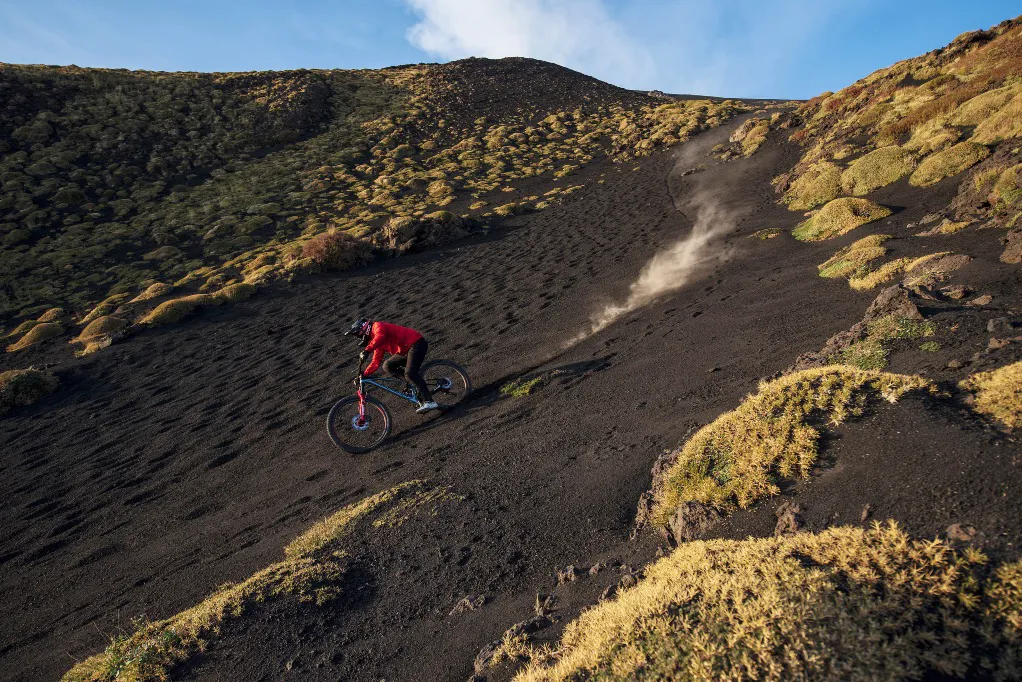Think of Etna’s crater as a lava sink with an opening at the bottom, leading to the unknown. I’ll have to slow down to zero before getting to the bottom to avoid sliding straight into hell. What am I thinking? First of all, even though Etna has been quiet for the last few weeks, it could wake up again at almost any time because it is one of the most active volcanoes in the world.

Etna’s height is changing following its volcanic activity. After the eruption in 1981, its peak was 3,350 metres but the release of magma caused the volcano to drop, so in 2018, the height was only 3,326 metres. The current volcano has four peaks: the Bocca Nuova, Voragine, Northeast Crater and Southeast Crater.
I have to be particularly careful because the surface is covered with sharp lava gravel. I discovered not to be the master of my handlebars after riding on the volcano slopes during the first test ride. The gravel is crumbling under the wheels, and all it took was a small mistake to fall over the handlebars. The result was a dislocated collarbone. It hurts but I can’t give up. Local people back in the town asked me why I was doing this. Why? Probably because I can. And because nobody else has ever done it before.
It wasn’t easy to find the date for the Etna run. Waiting for good weather is like waiting to win the lottery since Etna is often in the clouds and the winds at the summit are very strong. In autumn, the weather can change by the hour.
The risk of seismic activity is what we worry about. According to the volcano guides, Etna should stay quiet for at least two months for anyone to climb the peak safely. Our Sicily connection is Giuseppe Coco. As a local expert, heremotely informs us of the current situation so we can decide if it makes sense to travel 2,000 km. After Giuseppe texts me, we put everything in the car and go.
We can reach the peak in two directions. We chose the northern side, which starts in Piano Provenzana at an altitude of 1,800 metres. A so-called “lava bus” takes us up to 2,800 metres. The freely accessible zone ends at that point. Beyond this line, everybody needs the obligatory company of a volcanic guide. The services of guides are invaluable. During the ascent, the guide is in constant contact with the central office by radio and receives the latest information about changes in volcanic activity around the clock. Thanks to his experience, a guide is also well aware of the areas with the potential risk of danger. The climb is physically demanding. The cameraman and photographer had to carry all their equipment, weighing well over 20 kilograms. But finally, we’re on top.
The inside of the crater looks like a deep green-yellow carpet. At first glance, it looks like a wonderfully vibrant garden but in fact, the green colouring is due to the sulphur rising from the crater.
Photographer Miloš experienced the power of the sulphur firsthand after he knelt down for a moment to take photos. Half an hour later, his bare knee is peeking out of his crumbling trousers. The smoke from the volcano is so choking that we hold our breath many times.

I stand on the edge of the volcano and, after a brief moment of determination, begin to drop in. I grasp the handlebars tightly, my eyes searching for a safe path. I feel like descending down a giant chimney into the Titanic’s boiler room. The descent itself takes only a moment. It’s hot down there, and the air is cold. I have to scramble up on my own. I put my bike on my shoulders and climb while breathing heavily through the face mask. When I finally get over the edge, I feel dizzy and exhausted. But I can now say I’ve descended into the crater of Etna.
It’s also demanding coming down from 3,300 metres back to 1,800. The path is of cinder ash that crumbles and pulverises. Later, we realised how lucky we were when we saw snow falling only two days after we left the peak, changing Etna into an unreachable destination. We have a story to tell and an experience of our lives.
If the descent of Mount Etna wasn’t reason enough to visit Sicily, there’s pizza from Alfio at Pizzeria Belvedere that I can recommend. And what else? We would love to climb the Stromboli volcano in the future but given its volcanic activity in recent years, our goal seems almost impossible. But who knows?








